Email Customer Journey Mapping
Table of contents
- Email Customer Journey Mapping
- Email Marketing Customer Journey
- Key Stages of the Email Customer Journey
- Mapping the Email Customer Journey
- Why Is Email Journey Mapping So Important?
- How to Create and Implement Your Email Journey Map
- Best Practices for Email Mapping the Customer Journey
- Measuring the Email Map's Success and Customizing for the Customer Journey
- Conclusion
An effective marketing strategy depends on several factors, with one of the most crucial being the design of a well thought out and realistic process. In this process, email mapping focuses on the strategic planning of email content, and the email customer journey represents the overall experience and interaction customers have with email communications throughout their lifecycle.
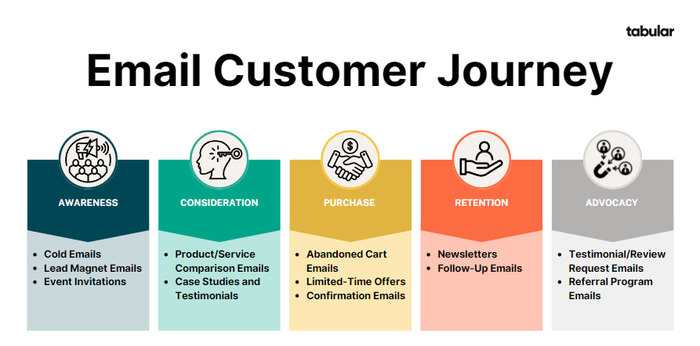
This is why it's vital to consider the user experience when crafting your marketing plan. An email customer journey map aids in identifying the right steps to help your customers make the most of your services. By highlighting the most efficient sales paths, it contributes to the success of your marketing strategy.
Even if you're beginning your email marketing journey, these systems can help you discover the most effective ways to achieve optimal click-through rates.
In this article, we’ll discuss creating an email customer journey map tailored to your business model. By the end, we hope you'll be ready to design your email marketing strategy using our examples.
Email Customer Journey Mapping
User or customer experience drives strong business relationships and fosters customer loyalty. Therefore, strategically mapping out your customers' potential journey throughout the process can be highly beneficial.
The customer journey encompasses the complete experience from beginning to end, focusing on how they feel, think, interact, or make purchases while engaging with your marketing campaigns. It lets you better understand consumer behavior and determine which marketing strategies resonate most effectively.
Since this journey can begin with simple yet important steps, such as designing an eye-catching visual, and continues through to the purchasing stage, email mapping is crucial.
It’s also important to remember that the email marketing journey may vary depending on your customers' demographics or your business model. Creating the best strategy requires gathering and analyzing data and refining your approach based on that analysis.
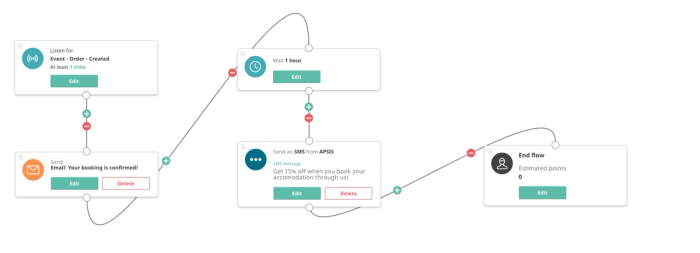
What Are Drip Marketing Campaigns and How to Use Them in Email Marketing
Managing a wide range of customers is challenging, but emails allow you to reach your audience directly. To take advantage of this and personalize your messages, you can use drip marketing campaigns.
A drip campaign is essentially a series of pre-scheduled, automated emails sent to your customers and clients based on specific milestone actions, such as signing up or subscribing.
These emails are designed to "drip" over time, gradually guiding users along their customer journey. Drip campaigns help you get the most out of your email marketing efforts by allowing personalized targeting and content, which works exceptionally well since the biggest advantage of email marketing is reaching the user directly.
In your email mapping, from the first interaction with the brand to advocacy, there are specific actions you'll take in this case, these actions are emails. A drip campaign enhances the stages of the email marketing customer journey and saves you a lot of time by automating the process.
How Drip Campaign Works
- Trigger: The campaign is activated by a specific action, such as a customer signing up for an email list, downloading travel guides, or making a purchase.
- Series of Emails: The first email might be a welcome email, followed by a second email a few days later showcasing your top destinations or services. A third email may be sent a week later, offering an exclusive deal or highlighting new benefits.
- Follow-Up: The emails are spaced out over time to keep your brand top-of-mind without overwhelming the recipient. The goal is to nurture the relationship and guide the customer toward a desired action, such as subscribing to your service or joining a loyalty program.
Email Marketing Customer Journey
Email is one of the most widely used mediums for online marketing, and the customer journey can be effectively crafted within email marketing as well. By using well-designed email templates, you can create the ideal sequence of steps for your customers to follow when promoting your product or service.
The customer journey may start with a catchy email subject line and turn into profit through a beautifully designed CTA button. In this process, every email at each step and every part of that email is critically important.
Email marketing is the most successful digital marketing method when it comes to conversions and direct sales. Here's how you can structure your email marketing campaign in alignment with the customer journey.
Key Stages of the Email Customer Journey
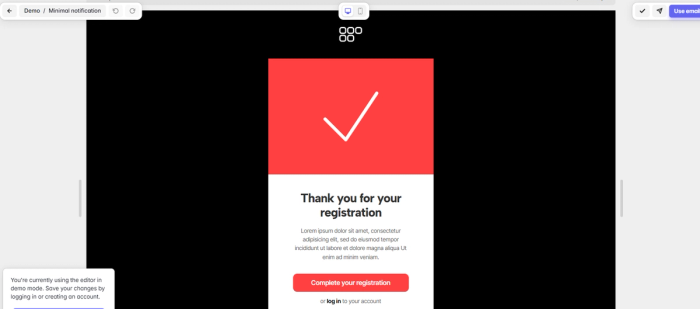
1. Awareness
Even though email marketing is not the most effective way to build brand awareness, it can still be a good alternative to organic search and social media. Who knows, maybe your cold email subject lines will perform better than anything else.
Cold Emails: Reaching out to potential customers who may not yet be familiar with your brand.
Lead Magnet Emails: Offering free resources or valuable content to entice new subscribers and create brand recognition.
Event Invitations: Inviting prospects to webinars, in-person events, or online meetups to boost their interest in your brand.
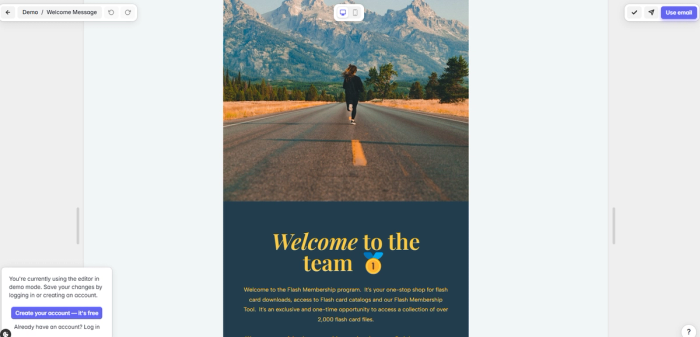
2. Consideration
At this stage, you aim to convince your customers or clients that your brand is the ideal choice for their needs. Customers evaluate various options based on their priorities; affordability, quick delivery, or high quality. If you can demonstrate that your brand offers all these benefits, they’ll be more inclined to purchase.
Product/Service Comparison Emails: Highlighting how your offerings stand out from the competition, helping prospects make informed decisions.
Case Studies and Testimonials: Sharing success stories from existing customers to build credibility and encourage further interest.
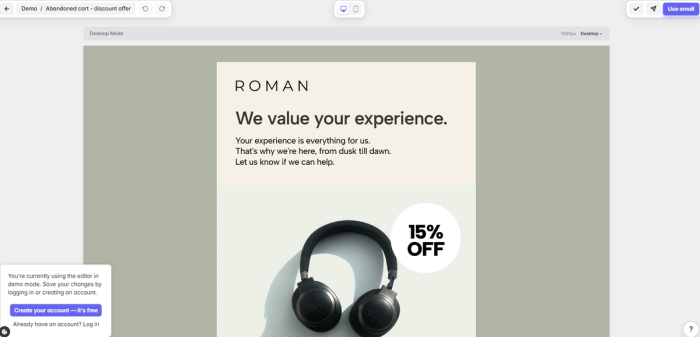
3. Decision/Purchase
Once you’ve positioned your brand as their top choice, the next step is encouraging customer engagement. Offering promotions, discounts, or time-sensitive deals can be an effective way to motivate them to purchase. Your email CTA design is of utmost importance at this stage.
Research on checkout usability shows that 61% of customers abandon their carts due to unexpected shipping costs. To counter this, you can highlight promotional campaigns in your marketing emails, such as free shipping or discounts, to further incentivize them to complete their purchase
Abandoned Cart Emails: Reminding customers of the items they've left behind and encouraging them to complete the purchase with promotional email templates.
Limited-Time Offers: Creating urgency with exclusive discounts or promotions that drive immediate action.
Confirmation Emails: Following up on completed purchases with confirmation details, receipts, and reassurance, setting the tone for a smooth transaction experience.
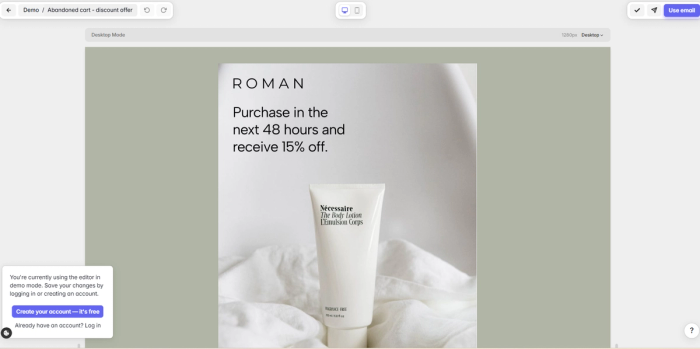
You can try these designer email templates, customize them for your brand, and test them out for free with Tabular. Tabular allows you to create your email templates with dynamic and interactive elements, all without needing to know how to code. What are you waiting for? Your competitors aren’t!
Create your template using our email template builder.
4. Retention/Loyalty
The email customer journey extends beyond the purchasing stage. It’s important to continue engaging with customers to build long-lasting and trusting relationships.
Remind them that they are not just one-time buyers but valued members of your community. You can achieve this by sending them educational blogs on topics of interest or by offering personalized deals tailored specifically for them.
Customers will appreciate excellent service and feel a stronger connection to your brand. Strive to create meaningful interactions that reinforce this connection and encourage ongoing loyalty
Newsletters: Regularly updating customers with relevant content, new products, and special offers to keep them engaged with your brand. Newsletter email templates are crucial for keeping your customers in the loop.
Follow-Up Emails: Checking in with customers post-purchase to ensure satisfaction and provide ongoing support.
5. Advocacy
Finally, email marketing encourages satisfied customers to become advocates for your brand.
For example, you can encourage subscribers to share their positive experiences with friends and family by providing them with unique referral codes and special offers. This approach helps build trust and strengthens their connection with your brand, reinforcing their sense of belonging.
Testimonial/Review Request Emails: Encouraging customers to share their experiences by submitting reviews or testimonials.
Referral/Affiliate Program Emails: Offering incentives for customers who refer your brand to friends and family, further expanding your reach.
Mapping the Email Customer Journey
We can summarize the customer journey email as guiding a potential customer from Point A to Point B. However, in this marketing approach, every visual they encounter and the information they read will be crafted in alignment with your brand.
Email Marketers often use visuals like tables, graphs, or diagrams to outline the steps of a marketing plan.
Since customer behavior is rarely linear, designing multiple pathways, alternative routes, or circular journeys can be highly advantageous. By creating a visual map, you can leverage the data collected from your marketing efforts to refine and improve your existing strategies
An email journey map is a strategic visualization of how email marketing supports and enhances a customer's experience with a brand throughout their entire customer journey. It outlines the specific types of emails that will be sent at each stage of the journey, what actions trigger these emails, and the goals they aim to achieve at each point.
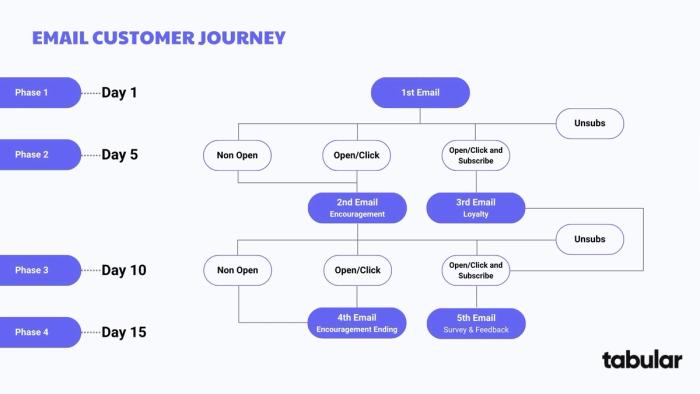
Why Is Email Journey Mapping So Important?
There’s a reason we refer to this approach as a journey. If you focus solely on the customer’s final destination, the likelihood of a successful sale may decrease. However, by paying attention to the stops and the overall experience your customer has when receiving the marketing email, you can build lasting relationships with loyal clients or customers.
Email journey mapping can help you develop the most effective sales model. By analyzing your sales data, you may identify specific customer personas. With this information, you can craft personalized email templates that drive engagement.
For example, if your customers often purchase multiple items in one transaction, You can create specific triggers for new releases that are tailored and include product recommendations in your emails to encourage additional sales and boost revenue.
Using key customer touchpoints is crucial in defining the overall timeline of the customer experience.
Research on customer behavior reveals that 88% of consumers view the experience provided by a company as equally important as the quality of its products or services. By mapping out these touchpoints, you can align them with your brand identity and visuals to create a cohesive customer journey.
How to Create and Implement Your Email Journey Map
Now that we've covered the significance of the email customer journey, it's time to begin planning and implementing your own.
You can personalize your email journey maps to align with your brand identity and priorities, based on data gathered along the way.
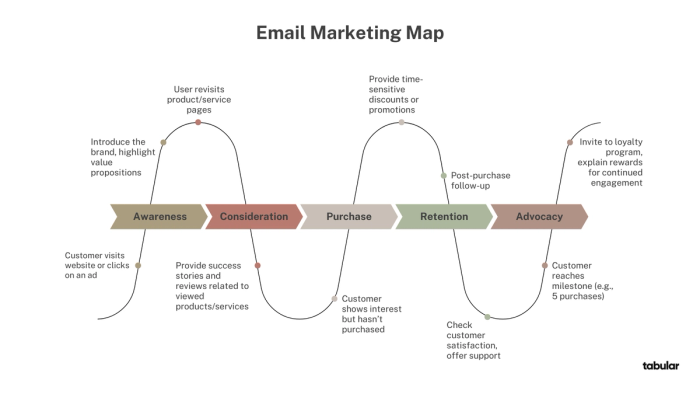
Step 1: Define Your Goals
To start, define the details and end goals of your email marketing strategy. By identifying your specific objectives, you can create a visual roadmap for your journey.
Use customer experience touchpoints to outline the basic steps in your email journey. These steps will guide you in achieving your goals, whether re-engaging existing customers or reaching out to new prospects.
Step 2: Create a Strategy
With your goals established, it's time to implement the key elements and lay out your steps systematically. Your timeline is flexible, and your understanding of your demographic is crucial.
Plan your emails based on their peak engagement times, weekly reminders, or preferred design styles. By making informed design decisions, you can effectively guide your customers through their journey
Step 3: Plan and Implement Automation
Now it’s time to take action. With your designs ready, implement your email customer journey automation according to the plan.
Schedule your emails carefully and use the data you’ve gathered on your customers to set triggers for appointment reminders, follow-up emails, newsletters, or whatever is necessary.
Step 4: Create Email Templates
Email templates play a crucial role in email mapping for the customer journey by keeping your email designs consistent, engaging, and tailored to the specific stage of the journey your customer is in. By using well-designed templates, businesses can maintain a professional appearance while saving time, as they allow for easy customization with personalized content that fits each customer segment.
Automated emails can sometimes look spammy, but email templates allow you to run your automated email campaigns without this issue by providing consistent and professional designs. Being consistent with your email header designs and using effective CTAs for each stage of the customer journey is key to success.
Step 5: Build and Optimize Your Automation Workflow
As you implement your email strategy, you'll gain insights into its performance. Use this information to refine and optimize your automation workflow.
Continuously update your strategy based on customer engagement and feedback. If you notice low metrics for your Call-to-Action buttons, consider reevaluating your approach and conducting tests to determine the most effective strategy.
Even the slightest change, such as using a serif font, can affect your campaign. Conduct A/B tests constantly.
| Customer Journey Stage | Trigger | Email Type | Content | Timing |
|---|---|---|---|---|
| Customer signs up to try an email template. | Welcome Email Series | Warm welcome, introduce brand’s mission, offer product/service highlights | Immediately + 3 days |
| User revisits product/service pages | Case Study/Testimonial Email | Provide success stories and reviews related to viewed products/services | After multiple visits |
| Customer shows interest but hasn’t purchased | Limited-Time Offer Email | Provide time-sensitive discounts or promotions | After multiple interactions |
| Post-purchase follow-up | Follow-Up Email | Check customer satisfaction, offer support | 7-10 days post-purchase |
| Loyal customer or positive review submitted | Referral Program Email | Offer unique referral codes with incentives for referrer and referee | After positive review |
Here is an easy example of email mapping for the customer journey. You can add additional steps and triggers; in fact, it's better to vary actions for each step. As you can see, you'll need a lot of email templates and will be editing those templates quite a bit along the way. Tabular offers a solution for email marketing campaigns with a drag-and-drop email builder.
Create your template using our email template builder.
Best Practices for Email Mapping the Customer Journey
We’ve covered how to work through each step of email journey mapping and provided you with an email mapping template. Here are some tips and tricks to help you maximize the efficiency of your strategy.
Common Pitfalls to Avoid in Email Mapping
It's important to base your decisions on accurate data gathered from customer statistics rather than assumptions about their behavior.
Assumptions can lead to unreliable strategies, so using statistical data, such as click-through rates, is crucial for refining your approach.
Customer feedback is equally important at this stage. Feedbacks provide essential insights into the effectiveness of each step in the journey and can highlight areas for improvement.
Make sure to respond to both positive and negative reviews to foster better communication and demonstrate that you value customer feedback. This approach will help you develop strategies that are more effective and better aligned with your customers' needs.
Maintaining a Customer-Centric Approach
Customer communication and trust are key to driving sales and fostering long-term repeat purchases. Pay close attention to your customers' needs and desires, especially when they are expressed.
Personalization is crucial for crafting optimized email customer journey maps. Incorporating product recommendations or special offers can keep your emails engaging. Additionally, using A/B testing and analyzing customer feedback can help refine your strategy and improve your process.
Tabular allows you to personalize email templates easily, which will impact the success of your email marketing campaigns. What are you waiting for? It's free to try!
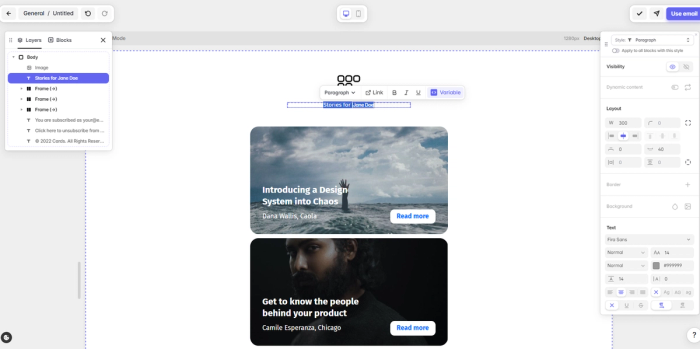
Throughout your interactions with customers, maintaining empathy and understanding is essential. As you develop your email mapping, approach it from the customers' perspective. This viewpoint will enhance your ability to create effective and appealing strategies.
Measuring the Email Map's Success and Customizing for the Customer Journey
Measuring customer engagement statistics is essential for optimizing email marketing efforts.
You can gauge the success of your email journey mapping by tracking key email metrics. For a more detailed explanation of these metrics, here are some simplified descriptions:
Open Rate measures the percentage of recipients who open your email. It helps you understand how effective your subject lines are in capturing attention.
Click-through Rate (CTR) reflects the percentage of recipients who click on the call-to-action buttons in your email, indicating how engaging and relevant your content is.
Conversion Rate shows the percentage of readers who complete a desired action, such as purchasing or downloading a resource. Maintaining a high conversion rate is crucial for achieving your end goals.
Unsubscribe Rate represents the percentage of recipients who opt out of future emails. A high unsubscribe rate may suggest that your marketing strategy needs adjustment to better align with customer expectations.
Using Feedback and Data for Improvement
While metrics provide valuable insights into your email marketing success, seeking direct customer feedback can offer even more actionable information.
Customers might complete a purchase but choose not to return if they encounter issues at any stage. Conversely, potential customers might abandon their purchase if they face problems on your website. Therefore, actively listening to customer feedback and refining your email customer journey map based on their experiences can be highly beneficial.
Consider sending brief, non-intrusive surveys to gather feedback on their overall journey or use live customer support to address any issues they might encounter during the purchasing or research phases. By doing this, you can improve user experience and necessary adjustments to enhance your email marketing strategy.
Continuous Optimization
Regularly testing and updating your approach helps maintain its effectiveness. Conduct A/B testing to determine which options resonate best with your audience, using the results to refine your strategy based on performance metrics.
Additionally, adjust the timing of your emails by analyzing open rates and unsubscribe rates. Overloading customers with too many emails or offers can make them feel overwhelmed or spammed. By maintaining a respectful frequency, you can stay on their radar without annoying, ensuring that your communications remain welcomed and impactful.
Conclusion
Email mapping for the customer journey is a highly effective strategy for engaging with customers.
Set clear goals to guide your email subscribers toward great offers, special deals, and increased revenue for your business.
By defining triggers in your email for each customer journey stage, such as awareness, consideration, decision, loyalty, and advocacy, you can effectively funnel customers to your website. More importantly, you can encourage customers to bring in more customers to your services.
Be mindful of your email frequency to avoid overwhelming customers, which could lead to them feeling spammed and unsubscribing.
Use metrics like click-through rates and open rates to determine which email map examples perform best.
Tabular, a drag-and-drop email template builder, is a powerful tool for mapping the customer journey. It allows you to quickly design and customize email templates for each stage, enabling you to create templates with the highest-performing visuals, header designs, and CTAs.
We hope this article has helped you understand the importance of and methods for using email marketing journeys. For user-friendly and free email templates, check out Tabular’s excellent options. Happy emailing!